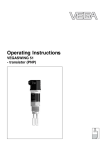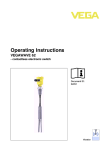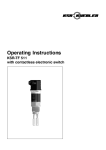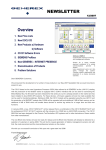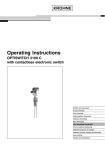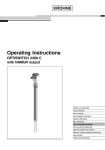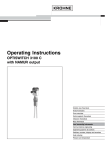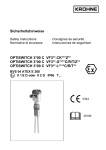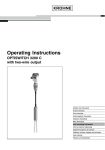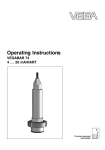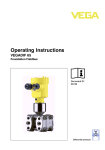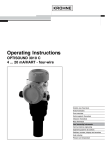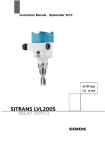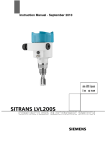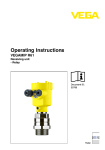Download Operating Instructions - OPTISWITCH 4000 C - with
Transcript
Operating Instructions OPTISWITCH 4000 C with transistor output Contents Contents 1 About this document 1.1 1.2 1.3 2 . . . . . . . . . . . . . . . . . . . . . . . . . . . . . . . . . . . . . . . . . . . . .. .. .. .. 4 4 4 4 Configuration. . . . . . . Principle of operation . Operation . . . . . . . . . Storage and transport . . . . . . . . . . . . . . . . . . . . . . . . . . . . . . . . . . . . . . . . . . . . . . . . . . . . . . . . . . . . . . . . . . . . .. .. .. .. 5 5 6 6 General instructions. . . . . . . . . . . . . . . . . . . . . 8 Mounting instructions . . . . . . . . . . . . . . . . . . . . 10 Preparing the connection . . . . . . . . . . . . . . . . . 13 Wiring plan . . . . . . . . . . . . . . . . . . . . . . . . . . . 14 Indication of the switching status . . . . . . . . . . . 18 Function test . . . . . . . . . . . . . . . . . . . . . . . . . . 18 Function chart . . . . . . . . . . . . . . . . . . . . . . . . . 19 Maintenance . . . . . . . . . . Rectify faults . . . . . . . . . . Exchange the electronics . Instrument repair . . . . . . . . . . . . . . . . . . . . . . . . . . . . . . . . . . . . . . . . . . . . . . . . . . . . . . . . . . . . . . . .. .. .. .. 20 20 21 22 Dismounting procedure . . . . . . . . . . . . . . . . . . 24 Disposal . . . . . . . . . . . . . . . . . . . . . . . . . . . . . 24 Technical data. . . . . . . . . . . . . . . . . . . . . . . . . 25 Dimensions . . . . . . . . . . . . . . . . . . . . . . . . . . . 28 OPTISWITCH 4000 C - with transistor output 31763-EN-060830 Supplement 9.1 9.2 2 . . . . Dismounting 8.1 8.2 9 . . . . Maintenance and fault rectification 7.1 7.2 7.3 7.4 8 . . . . Set up 6.1 6.2 6.3 7 . . . . Connecting to voltage supply 5.1 5.2 6 . . . . Mounting 4.1 4.2 5 Authorised personnel . . Appropriate use. . . . . . Warning about misuse . CE conformity . . . . . . . Product description 3.1 3.2 3.3 3.4 4 3 3 3 For your safety 2.1 2.2 2.3 2.4 3 Function . . . . . . . . . . . . . . . . . . . . . . . . . . . . . Target group . . . . . . . . . . . . . . . . . . . . . . . . . . Symbolism used . . . . . . . . . . . . . . . . . . . . . . . About this document 1 About this document 1.1 Function This operating instructions manual has all the information you need for quick setup and safe operation. Please read this manual before you start setup. 1.2 Target group This operating instructions manual is directed to trained, qualified personnel. The contents of this manual should be made available to these personnel and put into practice by them. 1.3 Symbolism used Information, tip, note This symbol indicates helpful additional information. Caution: If this warning is ignored, faults or malfunctions can result. Warning: If this warning is ignored, injury to persons and/or serious damage to the instrument can result. Danger: If this warning is ignored, serious injury to persons and/or destruction of the instrument can result. Ex applications This symbol indicates special instructions for Ex applications. List The dot set in front indicates a list with no implied sequence. à Action This arrow indicates a single action. 1 Sequence Numbers set in front indicate successive steps in a procedure. 31763-EN-060830 l OPTISWITCH 4000 C - with transistor output 3 For your safety 2 For your safety 2.1 Authorised personnel All operations described in this operating instructions manual must be carried out only by trained specialist personnel authorised by the operator. For safety and warranty reasons, any internal work on the instruments must be carried out only by personnel authorised by the manufacturer. 2.2 Appropriate use OPTISWITCH 4000 C is a sensor for level detection. Detailed information on the application range of OPTISWITCH 4000 C is available in chapter "Product description". 2.3 Warning about misuse Inappropriate or incorrect use of the instrument can give rise to application-specific hazards, e.g. vessel overfill or damage to system components through incorrect mounting or adjustment. 2.4 General safety instructions OPTISWITCH 4000 C is a high-tech instrument requiring the strict observance of standard regulations and guidelines. The user must take note of the safety instructions in this operating instructions manual, the country-specific installation standards (e.g. the VDE regulations in Germany) as well as all prevailing safety regulations and accident prevention rules. 2.5 CE conformity OPTISWITCH 4000 C is in CE conformity with EMC (89/336/ EWG), fulfils Namur recommendation NE 21 and NE 23 and is in CE conformity with NSR (73/23/EWG). Conformity has been judged according to the following standards: EMC: - Emission EN 61326: 1997 (class B) - Susceptibility EN 61326: 1997/A1:1998 l LVD: EN 61010-1: 2001 OPTISWITCH 4000 C - with transistor output 31763-EN-060830 4 l Product description 3 Product description 3.1 Configuration Scope of delivery The scope of delivery encompasses: l l l Components OPTISWITCH 4000 C level sensor Test magnet Documentation - this operating instructions manual - if necessary, certificates OPTISWITCH 4000 C consists of the following components: l l Housing with electronics process fitting with tuning fork Fig. 1: OPTISWITCH 4000 C 3.2 Principle of operation 31763-EN-060830 Area of application OPTISWITCH 4000 C is a level sensor with tuning fork for level detection. It is designed for industrial use in all areas of process technology and can be used in liquids. Typical applications are overfill and dry run protection. With a tuning fork of only 40 mm length, OPTISWITCH 4000 C can be also mounted, e.g. in pipelines from DN 25. The small tuning OPTISWITCH 4000 C - with transistor output 5 Product description fork allows use in vessels, tanks and pipes. Thanks to its simple and robust measuring system, OPTISWITCH 4000 C is virtually unaffected by the chemical and physical properties of the liquid. It functions even under difficult conditions such as turbulence, air bubbles, foam generation, buildup, strong external vibration or changing products. Fault monitoring The electronics module of OPTISWITCH 4000 C continuously monitors via frequency evaluation the following criteria: l l l Strong corrosion or damage on the tuning fork loss of vibration Line break to the piezo drive If a malfunction is detected or in case of power failure, the electronics takes on a defined switching condition, i.e. the output transistor blocks (safe condition). Physical principle The tuning fork is piezoelectrically energised and vibrates at its mechanical resonance frequency of approx. 1200 Hz. The piezos are fixed mechanically and are hence not subject to temperature shock limitations. The frequency changes when the tuning fork is covered by the medium. This change is detected by the integrated oscillator and converted into a switching command. Power supply OPTISWITCH 4000 C is a compact instrument, i.e. it can be operated without external evaluation system. The integrated electronics evaluates the level signal and outputs a switching signal. With this switching signal, a connected device can be directly activated (e.g. a warning system, a PLC, a pump etc.). The exact range of the power supply is stated in the "Technical data" in the "Supplement". 3.3 Operation The switching status of OPTISWITCH 4000 C can be checked with closed housing (signal lamp). Products with a density >0.7 g/cm³ (>0.025 lbs/in³) can be detected. Packaging 6 Your instrument was protected by packaging during transport. Its capacity to handle normal loads during transport is assured by a test according to DIN 55439. OPTISWITCH 4000 C - with transistor output 31763-EN-060830 3.4 Storage and transport Product description The packaging of standard instruments consists of environment-friendly, recyclable cardboard. For special versions, PE foam or PE foil is also used. Dispose of the packaging material via specialised recycling companies. Storage and transport temperature l 31763-EN-060830 l Storage and transport temperature see "Supplement Technical data - Ambient conditions" Relative humidity 20 … 85 % OPTISWITCH 4000 C - with transistor output 7 Mounting 4 Mounting 4.1 General instructions Switching point In general, OPTISWITCH 4000 C can be mounted in any position. The instrument must be mounted in such a way that the tuning fork is at the height of the requested switching point. The tuning fork has lateral marking (notches), marking the switching point with vertical mounting. The switching point refers to water (1 g/cm³ or 0.036 lbs/in³). When mounting OPTISWITCH 4000 C, make sure that this marking is at the height of the requested switching point. Keep in mind that the switching point of the instrument is shifted if the medium has a density other than water. 13mm (33/64") 13mm (33/64") 2 1 3 Fig. 1 2 3 2: Vertical mounting Switching point approx. 13 mm (0.51 in) Switching point with lower density Switching point with higher density 31763-EN-060830 8 OPTISWITCH 4000 C - with transistor output Mounting 1 2 Fig. 3: Horizontal mounting 1 Switching point 2 Switching point (recommended mounting position - particularly for adhesive products) Moisture Use the recommended cables (see chapter "Connecting to power supply") and tighten the cable gland. 31763-EN-060830 You can give your OPTISWITCH 4000 C additional protection against moisture penetration by leading the connection cable downward in front of the cable entry. Rain and condensation water can thus drain off. This applies mainly to mounting outdoors, in areas where moisture is expected (e.g. by cleaning processes) or on cooled or heated vessels. Fig. 4: Measures against moisture penetration Transport Do not hold OPTISWITCH 4000 C on the tuning fork. OPTISWITCH 4000 C - with transistor output 9 Mounting Pressure/Vacuum The process fitting must be sealed if there is gauge or low pressure in the vessel. Before use, check if the seal material is resistant against the measured product and the process temperature. The max. permissible pressure is stated in the "Technical data" in the "Supplement" or on the type label of the sensor. Handling The vibrating level switch is a measuring instrument and must be treated accordingly. Bending the vibrating element will destroy the instrument. Warning: The housing must not be used to screw in the instrument! Applying tightening force on the housing can damage its internal mechanical parts. To screw in, use the hexagon above the thread. 4.2 Mounting instructions Welded socket For welded socket with O-ring in front and welding marking. OPTISWITCH 4000 C has a defined thread runout point. This means that every OPTISWITCH 4000 C is in the same position after being screwed in. Remove therefore the supplied flat seal from the thread of OPTISWITCH 4000 C. This flat seal is not required when using a welded socket with front-flush O-ring. Before welding, unscrew OPTISWITCH 4000 C and remove the rubber ring from the welded socket. The welded socket has a marking (notch). For horizontal mounting, weld the socket with the notch facing upward or downward; in pipelines aligned with the direction of flow. 31763-EN-060830 10 OPTISWITCH 4000 C - with transistor output Mounting 1 Fig. 5: Marking on the welded socket 1 Marking Adhesive products In case of horizontal mounting in adhesive and viscous products, the surfaces of the tuning fork should be vertical in order to reduce buildup on the tuning fork. The position of the tuning fork is marked by a marking on the hexagon of OPTISWITCH 4000 C. With this, you can check the position of the tuning fork when screwing it in. When the hexagon touches the seal, the thread can still be turned by approx. half a turn. This is sufficient to reach the recommended installation position. In adhesive and viscous products, the surfaces of the tuning fork should protrude into the vessel to avoid buildup. Therefore sockets for flanges and mountings bosses should not exceed a certain length. 31763-EN-060830 30mm (1 3/16") Fig. 6: Adhesive products OPTISWITCH 4000 C - with transistor output 11 Mounting Inflowing medium If OPTISWITCH 4000 C is mounted in the filling stream, unwanted switching signals may be generated. Mount OPTISWITCH 4000 C at a location in the vessel where no disturbing influence from e.g. filling openings, agitators etc. can occur. Flows To minimise flow resistance caused by the tuning fork, OPTISWITCH 4000 C should be mounted in such a way that the surfaces of the blades are parallel to the product movement. 31763-EN-060830 12 OPTISWITCH 4000 C - with transistor output Connecting to voltage supply 5 Connecting to voltage supply 5.1 Preparing the connection Note safety instructions Generally not the following safety instructions: l Selecting the connection cable OPTISWITCH 4000 C is connected with standard cable with round cross section. Depending on the plug connection, you have to select the outer diameter of the cable respectively so that the seal effect of the cable gland is ensured. l l Cable glands Connect only in the complete absence of line voltage Valve plug DIN 43650, ø 4.5 … 7 mm Valve plug IDC method of termination DIN 43650, ø 5.5 … 8.0 mm Use cable with a round wire cross section and tighten the cable gland. 31763-EN-060830 When mounting outdoors, on cooled vessels or in humid areas, in which cleaning is carried out e.g. with steam or high pressure, it is particularly important to seal the cable gland. OPTISWITCH 4000 C - with transistor output 13 Connecting to voltage supply 5.2 Wiring plan Housing overview 1 Fig. 1 2 3 Plug versions 2 3 7: Overview of the connection versions M12x1 plug connection Valve plug DIN 43650 Valve plug DIN 43650 with IDC method of termination M12x1 plug connection This plug connection requires a preconfectioned cable with plug. Protection IP 66/IP 67. Valve plug DIN 43650 For this plug version, standard cable with round wire crosssection can be used. Cable diameter 4.5 … 7 mm, protection IP 65. 31763-EN-060830 14 OPTISWITCH 4000 C - with transistor output Connecting to voltage supply 4 5 1 2 3 6 7 8 10 Fig. 1 2 3 4 5 6 7 8 9 10 9 8: Connection, valve plug DIN 43650 Pressure screw Pressure disk Seal ring Fixing screw Seal washer Plug housing Plug insert Profile seal Control lamp OPTISWITCH 4000 C 31763-EN-060830 Valve plug - DIN 43650 - IDC method of termination For this plug version you can use standard cable with round wire cross-section. The inner cables must not be dismantled. The plug connects the cables automatically when screwing them in. Cable diameter 5.5 … 8.0 mm, protection IP 67. OPTISWITCH 4000 C - with transistor output 15 Connecting to voltage supply 4 1 Fig. 1 2 3 4 5 6 Transistor output 2 3 9: Connection, valve plug - DIN 43650 - IDC method of termination Compression nut Cable Split taper socket Seal insert Strand Plug housing For connection to binary inputs of a PLC with an input resistance <100 kOhm. Max. Min. 2 3 1 3 2 3 2 1 3 2 RL RL PA + - 10... 55V DC PA + 10... 55V DC 16 OPTISWITCH 4000 C - with transistor output 31763-EN-060830 Fig. 10: Wiring plan - Transistor output with valve plug DIN 43650 PA Potential equalisation RL Load resistor (contactor, relay etc.) Connecting to voltage supply Min. Max. 1 1 4 2 1 2 1 3 4 3 4 RL RL + 10... 55V DC + 10... 55V DC 11: Wiring plan (housing) - Transistor output with M12x1 plug connection Brown White Blue Black Load resistor (contactor, relay etc.) 31763-EN-060830 Fig. 1 2 3 4 RL 2 OPTISWITCH 4000 C - with transistor output 17 Set up 6 Set up 6.1 Indication of the switching status The switching status of the electronics can be checked on the upper part of the housing. 6.2 Function test OPTISWITCH 4000 C has an integrated test switch which can be activated magnetically. Proceed as follows to test the instrument: à Hold the test magnet (accessory) to the magnet symbol on the instrument housing Fig. 12: Function test The test magnet changes the current switching condition of the instrument. You can check the change on the signal lamp. Please note that the connected instruments are activated during the test. Caution: 18 OPTISWITCH 4000 C - with transistor output 31763-EN-060830 If OPTISWITCH 4000 C does not switch over after several tests with the test magnet, you have to check the plug connection and the connection cable and test the instrument again. If there is no switching function, the electronics will be defective. In this case you have to exchange the electronics or return the instrument to our repair department. Set up It is absolutely necessary that you remove the test magnet after the test from the instrument housing. 6.3 Function chart The following chart provides an overview of the switching conditions depending on the adjusted mode and level. Level Switching status Control lamp Mode max. transistor conducts Green Mode max. transistor blocks red Mode min. transistor conducts Green Mode min. transistor blocks red transistor blocks flashes red any 31763-EN-060830 Failure OPTISWITCH 4000 C - with transistor output 19 Maintenance and fault rectification 7 Maintenance and fault rectification 7.1 Maintenance When used as directed in normal operation, OPTISWITCH 4000 C is completely maintenance free. 7.2 Rectify faults Causes of malfunction OPTISWITCH 4000 C offers maximum reliability. Nevertheless faults can occur during operation. These may be caused by the following, e.g.: l l l l Sensor Process Power supply Signal processing Fault rectification The first measure to be taken is to check the output signal. In many cases, the causes can be determined this way and the faults rectified. Checking the switching signal ? Control lamps off l Voltage supply interrupted. à Check the voltage supply and the cable connection à Exchange the electronics module ? Signal lamp flashes red l There was no load connected when connecting to power supply à Connect the instrument correctly à Check if the tuning fork is damage or extremely corroded l Frequency error à Adjust the instrument correctly ? The signal lamp flashes alternately red and green l Shortcircuit or overload 20 OPTISWITCH 4000 C - with transistor output 31763-EN-060830 à Check the electrical connection Maintenance and fault rectification 7.3 Exchange the electronics To exchange the electronics in case of failure, it is not necessary to dismount the instrument. Dismounting the electronics module can destroy the housing seal. Therefore only open the instrument if you want to insert a new electronics module. The housing seal is supplied with the electronics module. You require an electronics module type SWE50T or SWE50C. If you want to use an electronics module with another signal output (e.g. contactless electronic switch SWE50C), you can download the suitable operating instructions manual from our homepage under Downloads. Take note of the specifications in the respective operating instructions manual. To exchange the electronics module, proceed as follows: 1 Separate OPTISWITCH 4000 C from operating voltage 2 Loosen screw (1) of the valve plug (2) with a wrench (loosen M12x1 plug connection by turning the compression nut) 3 Remove valve plug (2) or M12x1 acc. to drawing 4 Remove lateral fixing screw (7) with a crosstip screwdriver 5 Pull electronics module (4) carefully out of the housing (8) 6 Remove the plug of the connection cable (6) from the socket on the oscillator (4) 7 Set the 16-step rotating switch (5) of the new replacement electronics module (4) to the value of the defective electronics module 8 Insert the connection cable (6) in the socket of the new electronics module (4) 9 Insert electronics module (4) into the housing (8). Make sure that the lateral thread on the electronics module is above the hole on the housing (8) 10 Push the electronics module (4) flush into the housing (8) 11 Screw in the lateral fixing screw (7) with a crosstip screwdriver 31763-EN-060830 12 Plug the valve plug (2) to the instrument, make sure that the profile seal (3) is placed correctly 13 Tighten the screw (1) with a wrench (fasten M12x1 plug connection by screwing the compression nut) OPTISWITCH 4000 C is again ready for operation. OPTISWITCH 4000 C - with transistor output 21 Maintenance and fault rectification 1 2 3 4 5 6 7 8 Fig. 1 2 3 4 5 6 7 8 13: Exchange the electronics Fixing screw Valve plug DIN 43650 Profile seal Electronics module Rotary switch (16-steps) Plug connector Fixing screw Housing If a repair is necessary, please proceed as follows: You can download a return form from our website http://www. krohne-mar.com/fileadmin/media-lounge/PDF-Download/ 22 OPTISWITCH 4000 C - with transistor output 31763-EN-060830 7.4 Instrument repair Maintenance and fault rectification Specimen_e.pdf. By doing this you help us carry out the repair quickly and without having to call back for needed information. l l 31763-EN-060830 l Print and fill out one form per instrument Clean the instrument and pack it damage-proof Attach the completed form and possibly also a safety data sheet to the instrument OPTISWITCH 4000 C - with transistor output 23 Dismounting 8 Dismounting 8.1 Dismounting procedure Warning: Before dismounting, be aware of dangerous process conditions such as e.g. pressure in the vessel, high temperatures, corrosive or toxic products etc. Take note of chapters "Mounting" and "Connecting to power supply" and carry out the listed steps in reverse order. 8.2 Disposal The instrument consists of materials which can be recycled by specialised recycling companies. We use recyclable materials and have designed the electronic modules to be easily separable. WEEE directive 2002/96/EG This instrument is not subject to the WEEE directive 2002/96/ EG and the respective national laws (in Germany, e.g. ElektroG). Pass the instrument directly on to a specialised recycling company and do not use the municipal collecting points. These may be used only for privately used products according to the WEEE directive. Correct disposal avoids negative effects to persons and environment and ensures recycling of useful raw materials. Materials: see "Technical data" If you cannot dispose of the instrument properly, please contact us about disposal methods or return. 31763-EN-060830 24 OPTISWITCH 4000 C - with transistor output Supplement 9 Supplement 9.1 Technical data General data Material 316L corresponds to 1.4404 or 1.4435 Materials, wetted parts - Tuning fork 316L - Process seal Klingersil C-4400 - Process fittings 316L Materials, non-wetted parts - Housing 316L and plastic PEI Weight approx. 250 g (ca. 9 oz) Process fittings - Thread G¾ A, G1 A, ¾ NPT or 1 NPT - hygienic fittings Tri-Clamp 1", Tri-Clamp 1½", bolting DN 25 PN 40, bolting DN 40 PN 40, SMS Surface quality - Standard Ra <3.2 µm (1.26-4 in) - Ra <0.8 µm (3.15-5 in) hygienic version Measuring accuracy Hysteresis approx. 2 mm (0.08 in) with vertical installation Integration time approx. 500 ms Frequency approx. 1200 Hz Ambient conditions Ambient temperature on the housing -40 … +70 °C (-40 … +158 °F) Storage and transport temperature -40 … +80 °C (-40 … +176 °F) 31763-EN-060830 Process conditions Process pressure -1 … 64 bar (-14.5 … 938 psi) Process temperature - Standard -40 … +100 °C (-40 … +212 °F) Process temperature - High temperature version (option) -40 … +150 °C (-40 … +302 °F) Temperature shock no limitation Viscosity - dynamic 0.1 … 10000 mPa s Density 0.7 … 2.5 g/cm³ (0.025 … 0.9 oz/in³) OPTISWITCH 4000 C - with transistor output 25 Supplement Operation Plug connections Specification see "Connecting to power supply" Signal lamp (LED) - Green Output conductive - red Output blocked - Red (flashing) Failure - Output blocked Output variable Output Transistor output PNP Load current max. 250 mA (output - overload and permanently shortcircuit proof) Voltage loss max. 1 V Turn-on voltage max. 55 V DC Blocking current <10 µA Mode - min./max. Changeover by electronic connection - max. Overfill protection - min. Dry run protection Voltage supply Supply voltage 10 … 55 V DC Power consumption max. 0.5 W Electromechanical data Valve plug DIN 43650 - wire cross section 1.5 mm² (0.06 in²) - 4.5 … 7.0 mm (0.18 … 0.28 in) Cable outer diameter Valve plug DIN 43650 - IDC method of termination - wire cross section for wire cross-section of 0.5 … 1.0 mm² (0.02 … 0.04 in²) Single wire diameter >0.1 mm (>0.004 in) - Wire diameter 1.6 … 2.0 mm² (0.06 … 0.08 in²) - Cable outer diameter 5.5 … 8.0 mm (0.22 … 0.31 in) - Connection frequency 10 x (to the same cross-section) 26 OPTISWITCH 4000 C - with transistor output 31763-EN-060830 - Supplement Electrical protective measures Protection - Valve plug (DIN 43650) IP 65 - Valve plug IDC method of termination (DIN 43650) IP 67 - M12x1 plug connection IP 66/IP 67 Overvoltage category III Protection class II Approvals 31763-EN-060830 Overfill protection acc. to WHG OPTISWITCH 4000 C - with transistor output 27 Supplement 9.2 Dimensions OPTISWITCH 4000 C, standard version 2 3 42mm (1 21/32") 28mm (1 7/64") 158mm (6 7/32") 10mm (25/64") M12x1 ø31,7mm (1 1/4") 32 165mm (6 1/2") 35mm (1 3/8") 1 132,5mm (5 7/32") 42mm (1 21/32") 36mm (1 27/64") 27mm (1 1/16") 40mm (1 37/64") ø21,3mm (27/32") 4 13mm (33/64") L G3/4A, 3/4"NPT G1A, 1"NPT Fig. 1 2 3 4 L L L 14: OPTISWITCH 4000 C, standard version Thread G¾ A, G1 A, ¾ NPT or 1 NPT (M12x1)1) Thread G¾ A, G1 A, ¾ NPT or 1 NPT (valve plug DIN 43650) Thread G¾ A, G1 A, ¾ NPT or 1 NPT (valve plug DIN 43650 with IDC method of termination) Switching point Length with G¾ A, ¾ NPT: 66 mm (2.6 in) Length with G1 A, 1 NPT: 69 mm (2.7 in) Length with switching point = L + 48 mm (1.9 in) 28 Keep in mind that the total length is extended by the plug connection. OPTISWITCH 4000 C - with transistor output 31763-EN-060830 1) Supplement OPTISWITCH 4000 C, high temperature version 2 3 42mm (1 21/32") 28mm (1 7/64") 35mm (1 3/8") 1 42mm (1 21/32") 36mm (1 27/64") 27mm (1 1/16") 162,5mm (6 25/64") ø31,7mm (1 1/4") 32 182mm (7 11/64") 188mm (7 13/32") 10mm (25/64") M12x1 40mm (1 37/64") ø21,3mm (27/32") 4 13mm (33/64") L G3/4A, 3/4"NPT G1A, 1"NPT 31763-EN-060830 Fig. 1 2 3 4 L L L 15: OPTISWITCH 4000 C, high temperature version Thread G¾ A, G1 A, ¾ NPT or 1 NPT (M12x1)2) Thread G¾ A, G1 A, ¾ NPT or 1 NPT (valve plug DIN 43650) Thread G¾ A, NPT or 1 NPT (valve plug DIN 43650 with with IDC method of termination) Switching point Length with G¾ A, ¾ NPT: 66 mm (2.6 in) Length with G1 A, 1 NPT: 69 mm (2.7 in) Length with switching point = L + 48 mm (1.9 in) 2) Keep in mind that the total length is extended by the plug connection. OPTISWITCH 4000 C - with transistor output 29 Supplement 31763-EN-060830 30 OPTISWITCH 4000 C - with transistor output 31763-EN-060830 Supplement OPTISWITCH 4000 C - with transistor output 31 Subject to change without notice 31763-EN-060830


































